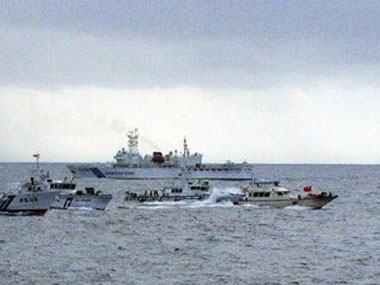On the high seas, sailors have mostly to battle the tedium of going from one unchanging day to the next. In recent times, however, sailors venturing anywhere into the East China Sea and the South China Sea have been given an adrenaline rush of excitement by Chinese fishing trawlers and surveillance ships who have been out to harass and intimidate them to assert China’s claims to sovereignty over the waters. So, late in July, when the radio on board the Indian navy vessel INS Airavat crackled to life off the coast of Vietnam, with a warning, ostensibly from a Chinese warship, suggesting that the Indian ship was entering Chinese waters, it is easy to imagine the frisson of nervous excitement that must coursed through the decks. After all, the seasoned seamen would have been aware of the incident that happened exactly a year ago, when a Chinese fishing trawler deliberately rammed a Japanese Coast Guard vessel ( video here) in disputed waters off the Senkaku islands. It led to a diplomatic incident that ended with Japan tamely giving into China’s hectoring demands to release the captain of the trawler, who returned to a hero’s welcome in China. They would also have been aware of what happened in December 2010 when another high seas confrontation between a Chinese fishing trawler and a South Korean coast guard vessel ( video here) resulted in the sinking of the trawler. Or of another tense stand-off between a Chinese marine surveillance vessel and a Vietnamese oil survey ships ( video here) in the South China Sea in May this year. Yet, going by Indian accounts, the sailors of INS Iravat experienced no such high-seas drama: after the mysterious voice on the radio asked the vessel to identify itself and explain its presence (even though it was only in international waters off Vietnam), Iravat steamed on right on schedule without any further interference. Indian officials have systematically denied media reports that the episode was rather more dramatic, and involved a “confrontation” in the high seas, the first of its kind between the navies of the two countries. [caption id=“attachment_75704” align=“alignleft” width=“380” caption=“Even if Indian vessels scrupulously stick to international waters, they will run foul of Chinese perceptions of sovereignty over a vast swathe of the South China Sea. AFP”]  [/caption] Even if that were indeed the case, it would be folly for the Indian government to respond defensively to the episode, as it has thus far. In its defence, the Indian vessel was inarguably in international waters when it received the radio warning, except that China doesn’t recognise it as such. Given the compulsions of India’s economic and strategic engagement with the South East Asian and East Asian community, Indian vessels will increasingly have to ply in those waters – which will perforce put them in conflict with China’s claims. Assertion of Chinese nationalism Some of this is rooted in the very nature of the Chinese assertion of national interests by invoking nationalism, for instance by manipulating sentiments through such confrontational episodes. As strategic analysts at the Lowy Institute for International Policy noted recently, “the growth of regional regional navies, and their more conspicuous use in asserting national interests, reflects the increased influence of nationalism in defence policy and posture. This seems especially so in China.” Nationalism, note the Lowy strategists, remains a key pillar of legitimacy for the Chinese Communist Party.“This is beginning to manifest itself, among other ways, in the emerging force structure of the People’s Liberation Army-Navy (PLA-N). For instance, national pride would seem a major reason for China’s decision to acquire an aircraft carrier. China’s naval nationalism might thus be seen as a ‘prestige strategy’: the Communist Party seeking to reinforce its domestic position through its external security posture.” In their opinion, nationalism may also influence how the Chinese navy is used. “So some assertive Chinese maritime behaviour may be intended as a demonstration of naval capability to Chinese audiences, designed to reinforce the status of China’s leadership and military as defenders of sovereignty. From a PLA-N perspective, there may even be institutional motivations for confrontational interactions at sea, namely to secure greater resources for naval development by emphasising the contested nature of China’s maritime frontiers.” Distraction from a domestic crackdown Other commentators too point out that China’s “increasingly aggressive posture” towards its neighbours may by driven, in some measure, by domestic compulsions. Notes Zachary Keck, a foreign policy analyst, “The more assertive Chinese posture is likely the product of both a permissive regional environment that presents Beijing with the opportunity to assert itself, and its own domestic turmoil, which provides Chinese policymakers a reason to foment distracting confrontation abroad. The economic enfeeblement of the US and its enduring distractions with West Asia in the context of the Arab Spring, coupled with the triple whammy that Japan experienced in March with the earthquake-tsunami-nuclear reactor crisis meant that China sensed the regional environment was conducive for a show of might without the risk of pushback. And domestically, China, which had been unnerved enough by the prospect of the spread of the Jasmine Revolution to crackdown on activists, needed to “divert the public’s attention away from its ramped up repression.” Confrontation abroad could best accomplish this, notes Keck. Particularly after US Secretary of State Hillary Clinton, during her recent visit to India, urged India to “not just Look East but to Engage East” and cooperate with the US in keeping sea lanes open for navigation in the Asia Pacific, China will be wary of Indian “incursions” in its backyard. Even if Indian vessels scrupulously stick to international waters, they will run foul of Chinese perceptions of sovereignty over a vast swathe of the South China Sea. Lowy Institute strategists reason that India and China will sooner or later need a “maritime confidence-building regime” of their own, particularly since China is increasingly looking to projects its naval power in the Indian Ocean, which is India’s backyard. Given that Sino-Indian confidence-building measures haven’t worked too well on land, there’s no reason to reckon that they will fare better in the high seas. China’s non-discriminating assertiveness against virtually all its neighbours (to the point where some of them want to have the South China Sea renamed) provides them a platform to unite to push back against China. Yet, India has thus far been reluctant to align itself with any formation for fear of antagonising China. The belief that China will be placated if Indian officials walk softly on eggshells has been comprehensively disproved. To persist in that defensive posturing is to grossly misread the reasons for Chinese power projection. Sooner or later, the radio of Indian vessels plying in the South China Sea will crackle to belligerent life. And the next time around, the denouement may not be as tame as it was this time…
Whatever the nature of the ‘confrontation’ involving Indian and Chinese navies in the South China Sea, the Indian strategy of tamely giving in won’t earn any respite.
Venky Vembu attained his first Fifteen Minutes of Fame in 1984, on the threshold of his career, when paparazzi pictures of him with Maneka Gandhi were splashed in the world media under the mischievous tag ‘International Affairs’. But that’s a story he’s saving up for his memoirs… Over 25 years, Venky worked in The Indian Express, Frontline newsmagazine, Outlook Money and DNA, before joining FirstPost ahead of its launch. Additionally, he has been published, at various times, in, among other publications, The Times of India, Hindustan Times, Outlook, and Outlook Traveller. see more


)

)
)
)
)
)
)
)
)



